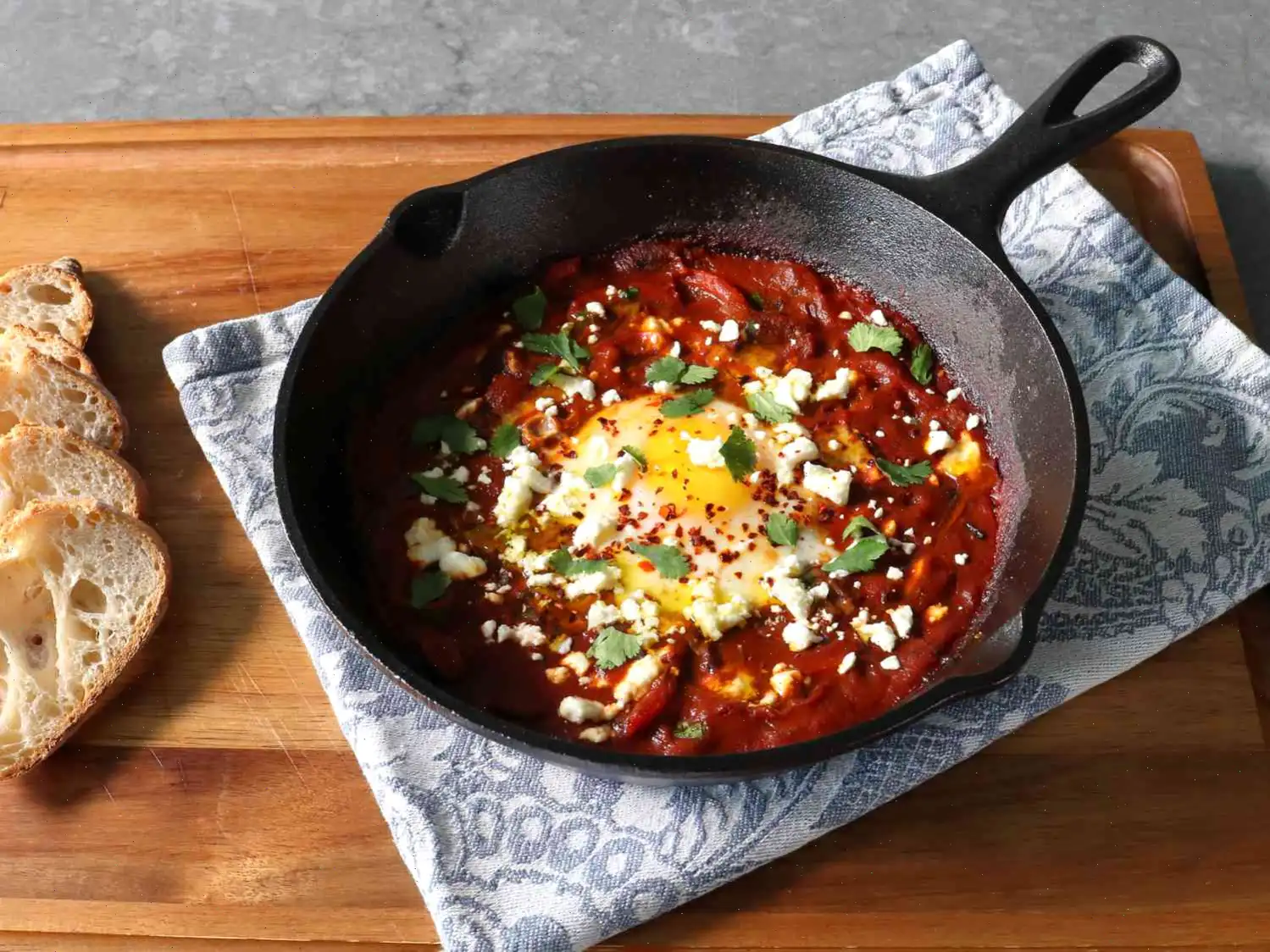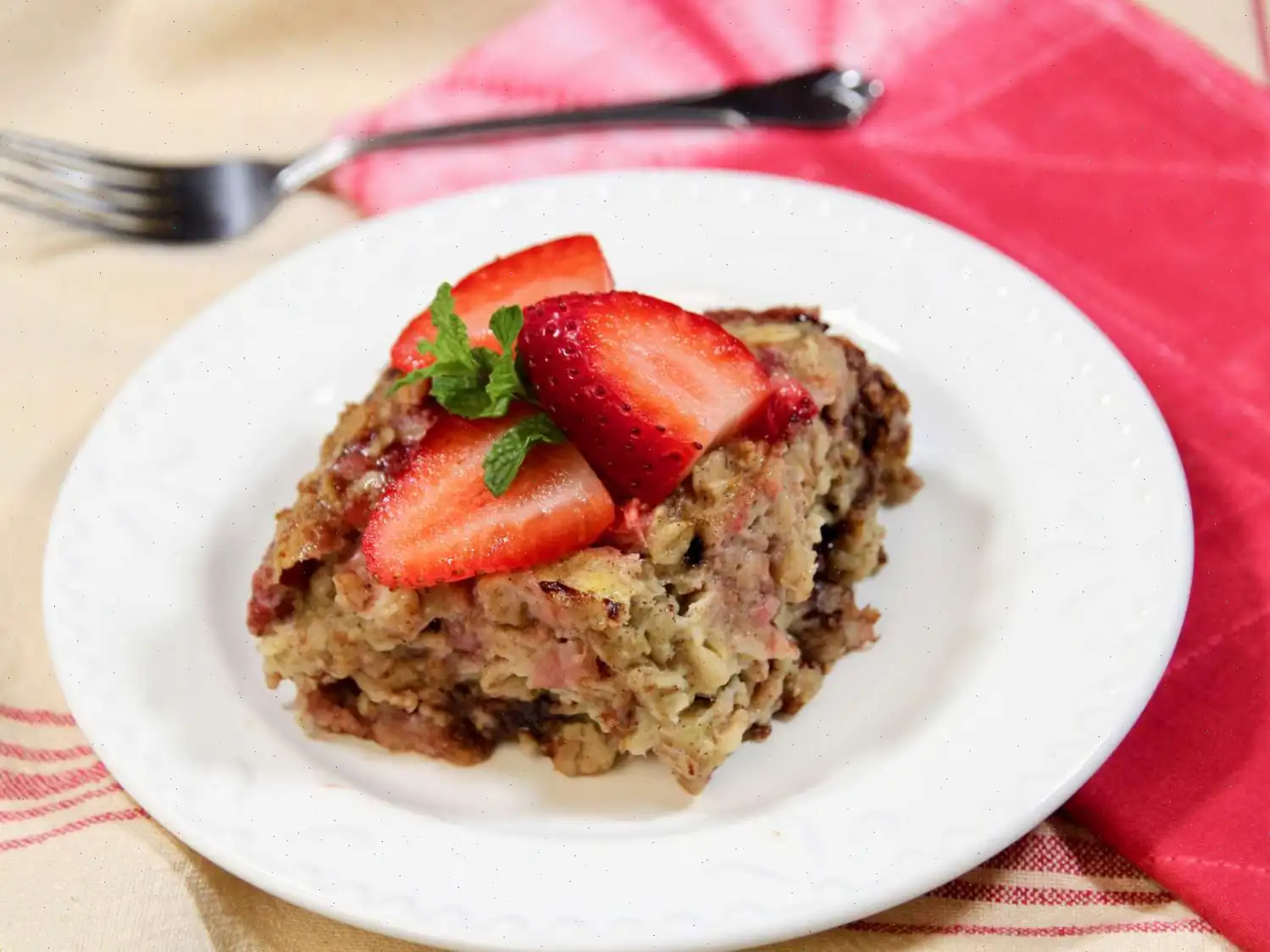
Shakshuka for One Recipe
Shakshuka is a fantastic dish that brings the perfect balance of rich flavors and vibrant textures, making it an unforgettable breakfast experience. The combination of runny eggs nestled in a spicy, aromatic tomato-pepper sauce elevates this dish to a whole new level. Whether you grow your own vegetables or purchase them, shakshuka is a great way to use up fresh, seasonal produce like tomatoes, peppers, and herbs. So, if you're looking for a quick, flavorful meal, shakshuka should be your go-to!
Ingredients:
- 2 tablespoons olive oil, divided
- 2 button mushrooms, sliced
- 1/4 cup sliced red onion
- 1/2 cup sliced hot peppers and/or sweet peppers
- 1/4 teaspoon kosher salt, or to taste
- 1/2 teaspoon ground cumin
- 1/2 teaspoon smoked paprika
- 1/8 teaspoon ground turmeric
- 1/8 teaspoon dried oregano
- 1/8 teaspoon ground black pepper, plus more to taste
- 1 pinch cayenne pepper
- 1/2 cup tomato puree or sauce
- 1/4 cup water, or more as needed
- 2 tablespoons chopped fresh cilantro, divided
- 2 tablespoons crumbled feta cheese, divided
- 1 large egg
- 1 pinch Aleppo chili flakes (optional)
- Sliced bread to serve alongside
Directions:
Step 1: Heat 1 tablespoon of olive oil in a small pan or skillet over medium-high heat.
Step 2: Add the sliced mushrooms in a single layer and sprinkle them with a pinch of salt. Layer the red onions on top, followed by the peppers, and sprinkle everything with another pinch of salt.
Step 3: Allow the mushrooms to start sizzling and cook for about 3 minutes until theyre browned on the bottom. Stir everything together and cook for an additional 1 minute.
Step 4: Add cumin, paprika, turmeric, oregano, black pepper, and cayenne. Stir everything together and cook for another 30 to 60 seconds to allow the spices to bloom.
Step 5: Pour in the tomato puree and water. Let the mixture come to a simmer, then stir in half of the chopped cilantro.
Step 6: Scatter half of the crumbled feta cheese into the sauce.
Step 7: Use a spoon to make a well in the center of the sauce and gently crack the egg into the well.
Step 8: Reduce the heat to medium-low, cover the pan, and cook the egg until its done to your liking about 3 to 5 minutes. Keep in mind that the egg will continue to cook a little more in the hot sauce after removing it from the heat.
Step 9: Serve immediately, topping the dish with Aleppo chili flakes (optional), the remaining olive oil, feta cheese, and cilantro. Serve with sliced bread on the side to soak up all the delicious sauce.
Chef's Notes:
The egg can be slightly undercooked since it will continue to cook a little more in the hot sauce after it is removed from the heat.
Nutrition Facts (per serving):
- Calories: 530
- Fat: 38g (49% of daily value)
- Saturated Fat: 8g (42% of daily value)
- Cholesterol: 203mg (68% of daily value)
- Sodium: 1291mg (56% of daily value)
- Total Carbohydrates: 36g (13% of daily value)
- Dietary Fiber: 6g (21% of daily value)
- Total Sugars: 14g
- Protein: 16g (31% of daily value)
- Vitamin C: 130mg (144% of daily value)
- Calcium: 220mg (17% of daily value)
- Iron: 6mg (32% of daily value)
- Potassium: 885mg (19% of daily value)
The Origins and History of Shakshuka
Shakshuka, a vibrant dish of eggs poached in a spiced tomato and pepper sauce, traces its roots to North Africa, particularly Tunisia, though it has become widely popular across the Middle East. Its name comes from the Arabic word for a mixture, which perfectly describes the medley of vegetables, spices, and eggs that define the dish. Historically, shakshuka was a humble, home-cooked meal, designed to make the most of fresh, local produce. Over the decades, it traveled with Jewish immigrants from North Africa to Israel, where it gained a permanent place on breakfast tables and in cafs nationwide.
Regional Variations and Specialties
Although the core ingredientstomatoes, peppers, onions, and eggsremain consistent, shakshuka shows notable regional differences. Tunisian versions tend to be spicier, often incorporating harissa, a chili paste that gives the dish a fiery kick. In Israel, shakshuka might include feta cheese or olives, adding a Mediterranean twist. Moroccan interpretations sometimes add preserved lemons or cumin-heavy spice blends, while Egyptian variants might include garlic and fresh herbs like cilantro and parsley. Each variation highlights local tastes while keeping the dishs comforting, rustic character intact.
How Shakshuka Differs from Similar Dishes
While shakshuka shares similarities with other tomato-and-egg dishes, such as the Turkish menemen or the Italian eggs in purgatory, its distinctive combination of spicessmoked paprika, cumin, turmeric, and sometimes cayennesets it apart. The slow-simmered tomato sauce, which becomes deeply flavorful and slightly thickened, creates a unique environment for poaching eggs, resulting in a luscious, runny yolk surrounded by a savory, spiced sauce. Unlike scrambled eggs or frittatas, shakshukas eggs remain intact, offering a visually striking and texturally distinct experience.
Where Shakshuka Is Commonly Served
Traditionally, shakshuka is enjoyed as a breakfast or brunch dish, often accompanied by warm, crusty bread to soak up the rich tomato sauce. In Middle Eastern countries, it is a staple in cafs and home kitchens alike. In Israel, for instance, it is a ubiquitous caf offering, often garnished with fresh herbs, feta, or chili flakes. Globally, shakshuka has made its way onto brunch menus in cosmopolitan cities, celebrated for its bold flavors and rustic presentation, perfect for both casual dining and social gatherings.
Interesting Facts About Shakshuka
- The dishs simple ingredients make it highly adaptable, allowing cooks to incorporate seasonal vegetables or even proteins like sausage or mushrooms.
- Shakshuka is celebrated not just for taste but for its nutritional value: the combination of eggs and vegetables provides protein, fiber, vitamins, and minerals in a single meal.
- The runny yolk is considered the highlight of the dish, making it a favorite for those who enjoy rich textures and flavors.
- Despite its traditional roots, shakshuka has been embraced globally as a versatile dish suitable for breakfast, lunch, or even dinner.
- In modern culinary culture, shakshuka is often featured in cooking competitions and online recipes for its vibrant color and appealing presentation.
You can listen to this recipe in AI audio format. Simply click the play button below to listen to the content in a format that suits you best. It’s a great way to absorb information on the go!
FAQ about Shakshuka for One Recipe
Comments
Maria Lee
02/13/2025 12:03:46 AM
The only difference was that there were 4 mushrooms and 2 eggs instead of 1. It was delicious!
Virginia Nguyen
10/24/2023 10:42:20 AM
This recipe is simple and delightful! I discovered that pre-chopping all the ingredients and pre-measuring the spices (I placed mine in a small bowl) and tomatoes (I opted for canned diced) made the cooking process quicker and more relaxed. I made a few additions as well: I included an extra egg, a pinch of salt at the end, and a bit of garlic powder.
Frank Lee
01/10/2023 06:44:58 AM
I was pleasantly surprised by how delicious this recipe turned out to be! It was a hit with everyone in my household. It's a fantastic way to combine eggs with vegetables and ensure you're getting enough protein. The step-by-step instructions were easy to follow, and the use of simple ingredients made the whole process a breeze. Huge kudos to the creator for this wonderful recipe!
George Taylor
09/24/2023 03:39:02 AM
I only made one change by using diced fire-roasted tomatoes instead of the puree. It turned out to be delicious.
Helen White
07/21/2023 12:31:12 PM
Great taste! While there is some preparation required for the vegetables and spices, it can be done in advance. I opted for red bell peppers over spicy ones and skipped adding Aleppo pepper at the end, yet the dish still had a satisfying peppery kick.
Justin Wilson
12/05/2024 10:54:46 PM
This dish was absolutely delightful! The seasoning blend was spot on. I tend to season to my liking without measuring, and I must say, I am a huge fan of Aleppo pepper flakes. The only alteration I made was incorporating some leftover sliced steak, although I believe it would have been even better without it. Overall, it was incredibly delicious!








